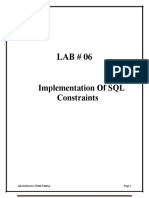100% found this document useful (1 vote)
53 views15 pagesConstraints
SQL constraints are used to specify rules for data in tables. Common constraints include NOT NULL, UNIQUE, PRIMARY KEY, FOREIGN KEY, CHECK, DEFAULT and INDEX. Constraints ensure accuracy and reliability of data, and if violated the action is aborted.
Uploaded by
pranita27someshCopyright
© © All Rights Reserved
We take content rights seriously. If you suspect this is your content, claim it here.
Available Formats
Download as DOCX, PDF, TXT or read online on Scribd
100% found this document useful (1 vote)
53 views15 pagesConstraints
SQL constraints are used to specify rules for data in tables. Common constraints include NOT NULL, UNIQUE, PRIMARY KEY, FOREIGN KEY, CHECK, DEFAULT and INDEX. Constraints ensure accuracy and reliability of data, and if violated the action is aborted.
Uploaded by
pranita27someshCopyright
© © All Rights Reserved
We take content rights seriously. If you suspect this is your content, claim it here.
Available Formats
Download as DOCX, PDF, TXT or read online on Scribd
/ 15
























































































